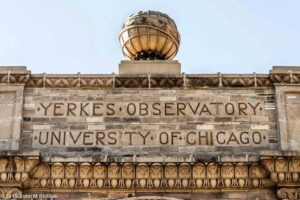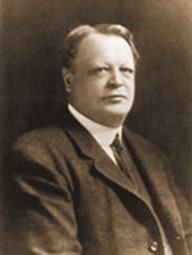by Ron Becker, Class of 2019

The Yerkes Observatory is the fruition of the efforts of the triumvirate of George Ellery Hale (astronomer/scientist), Charles Tyson Yerkes (financier), and Henry Ives Cobb (architect).
George Ellery Hale was born in Chicago on June 29, 1868, the son of William Ellery Hale. His father was a millionaire who made his money in passenger elevators and real estate development. Among his projects was the Reliance Building at State and Washington Streets. An inquisitive youth, George showed a proclivity for science and mechanical gadgets. He built his first telescope at the age of 14. His father bought him a second-hand 12 inch Clark telescope and had an observatory built on the family property in the Kenwood section of Chicago. Hale was educated at MIT, the Harvard College Observatory, and in Berlin. Eventually a laboratory, library, and observatory were built on property adjacent to the family home. This became the Kenwood Astrophysical Observatory.

In 1892, William Hale and William Rainey Harper, the President of the University of Chicago, reached an accommodation wherein the university received the use of the observatory, William Hale pledged some financial support, George Hale was appointed associate professor of astrophysics, the first such position, and the university would attempt to raise $250,000 for the construction of a new observatory. George had few administrative or teaching responsibilities at the university and appears to have spent most of his time designing the new observatory. In late 1892 he learned of the existence of two 40” glass discs that would be ideal as lenses for a telescope. Hale and Harper approached Charles Tyson Yerkes with a proposal to finance the construction of what would be the world’s largest refracting telescope. Unknowingly, they had hit upon one of Yerkes’ secret ambitions. “I don’t care what the cost, send me the bill,” Yerkes told journalists at the time. “I will spend a million dollars to lick the Lick.” The Lick Observatory in California had a 36-inch refracting telescope, the largest in the world at the time. Yerkes had planned to finance only the construction of the telescope and its mount. Hale and Harper, perhaps intentionally misconstruing his words, leaked to the press that Yerkes had promised to build the telescope and an observatory to house it. Backed into a corner, Yerkes agreed to finance the observatory. His total expenditure has been reported as $349,000. The Chicago Times reported, “It begins to look as if President Harper’s success as a money raiser was due to his having shrewdly represented the Chicago university to divers men of wealth as a sort of conscience fund.” The quote was also referencing John D. Rockefeller’s endowment to the university.
Charles Tyson Yerkes was born in Philadelphia on June 25, 1837. As a young man he was a very successful broker and investor but became enmeshed in the city’s political corruption. He had devised a highly leveraged stock scheme, using, in part, City of Philadelphia funds deposited with him. He intended to become a millionaire. His scheme was thwarted when the Great Chicago Fire in October, 1871 caused a stock market panic resulting in a large stock sell-off, especially of the railroad stocks that Yerkes was holding. He was unable to meet the margin calls and had to declare bankruptcy. His scheme was uncovered, and he was sent to the penitentiary. When he threatened to divulge what he knew about corruption, he was hastily pardoned to keep him quiet. He was able to recoup much of his wealth in shrewd trading during the financial panic of 1873.
While he was profiting financially, Yerkes realized he would never succeed in reaching the social status he sought. In 1881 he fled Philadelphia with his mistress for Fargo, North Dakota, and its liberal divorce laws. He divorced his wife and married his mistress. Later in 1881, he arrived in Chicago. His original intent was to become a grain broker but soon turned his attention to acquiring streetcar lines. He used bribes, threats, blackmail, and convoluted financial schemes to achieve his goals. It was reported that he brought a new level of corruption to the Windy City. His underwriting of the observatory was an attempt to foster some goodwill and be more accepted. To some extent he succeeded. One newspaper triumphed, “YERKES BREAKS INTO SOCIETY: Street-Car Boss Uses a Telescope as a Key to the Temple Door AND IT FITS PERFECTLY.” However, he reverted to his shady dealings.
Yerkes was originally opposed to elevated railroads but got involved with them as a defensive measure to protect his streetcar lines. Sensing that if the various elevated railroads could be extended into the business district considerable profits could be made, he was singularly responsible for building the Chicago Loop structure. The “Loop” was completed in 1897. That same year Yerkes overplayed his hand in seeking 99-year extensions for his streetcar lines. Facing a reform movement in the City Council, his effort was defeated. He then liquidated his Chicago holdings with a substantial profit and in 1898 moved to New York City. There he built mansions for himself, his art collection, and his new mistress. He was attracted to London to work on its subway system. Before he could accomplish much, he was taken ill and returned to New York. He died in a hotel room at the Waldorf Astoria on December 29, 1905.
Yerkes commissioned Henry Ives Cobb to design the observatory. He was said to have known Cobb personally, although the nature of the relationship was not spelled out. It could have been because both were well-known and well-respected art collectors. (To learn more about Yerkes’ art collection see: Chicago history: Rediscovering the art of the much-demonized Chicago wheeler-dealer Charles Tyson Yerkes | Patrick T Reardon | Writer, Essayist, Poet, Chicago Historian) Another possible connection might have been the Chicago Athletic Association of which both were reported to have been members. Certainly Yerkes aspired to the social status achieved by Cobb.
Cobb would have been a logical choice since he was the architect for many of the buildings on the University of Chicago campus. These buildings were mostly designed in the “collegiate gothic” style. Cobb had also previously designed an observatory, The Dearborn Observatory on the Northwestern University campus in 1887.

Cobb designed the observatory according to George Hale’s specifications. Most observatories at that time were merely buildings housing the telescope. The Yerkes Observatory has three domes housing telescopes, including the largest housing the 40 inch refracting telescope. Since Hale was primarily interested in astrophysics, the study of the nature of the stars and galaxies, the complex included laboratories, a darkroom, workshops, a library, classrooms, dormitories, and storage space. Construction was begun in 1895 and completed in 1897, with the grand opening on October 21. The observatory is in Williams Bay, Wisconsin, on the shore of Lake Geneva.
Henry Ives Cobb designed many of his most memorable buildings in the Richardsonian Romanesque style. These would include the Union Club in 1881, the design of that was the winner of a design contest and brought him to work in Chicago. Other buildings include the original Chicago Historical Society Building and the Newberry Library. This is the style he adapted to the Yerkes Observatory. He married it with Greco-Roman ornamentation.



There are striking similarities between the Yerkes Observatory and the Fisheries Building designed by Henry Ives Cobb for the 1893 Columbian Exposition.


Walt Chadick, pictured below, is the Director of Programs and External Affairs for the Yerkes Future Foundation, the organization to which the University of Chicago ceded the observatory and its grounds. Walt leads the tours of the observatory, and he noted that Cobb reused some of the molds from the Fisheries Building for some of the decorations at the observatory.

Yerkes Observatory is festooned with decorations rich with symbolism and whimsy. Mythological symbols and religious symbols are intermixed, reflecting the close relationship of the two realms since humankind’s earliest history. There are also many grotesques and whimsical depictions, including several of Yerkes as a devil or satyr.
The grounds of the Yerkes Observatory were designed by the Olmstead Brothers. They are currently being replanted to recreate the original scheme. The Olmstead Brothers also designed the landscapes of many of the estates that dot the shoreline of Lake Geneva. The history of Lake Geneva as a destination for the rich and famous dates back to the Great Chicago Fire of 1871. That year direct rail service was initiated between Chicago and Lake Geneva. Many Chicagoans came to the area while Chicago was being rebuilt. Several palatial mansions, summer retreats really, were built such that Lake Geneva earned the sobriquet of “Newport of the Midwest.” Surely, Yerkes did not object to having his name on a great building among such exalted company.
On a final note there is a crater on the moon named Yerkes. Whether it is named for the man or for the excellent work done at the observatory is not certain. Fittingly, it is in the Mara Crisum or Sea of Crises.

___________________________________________________________________________________________

CLICK HERE for more stories on The Bridge.












Fabulous research and story, Ron. Thanks so much for increasing our knowledge of Yerkes and Cobb.
Great story. Is the Yerkes Observatory open to the public? Tom
Hi, here is a link to the upcoming tour dates: https://yerkesobservatory.org/visit/plan-a-visit/
Thanks Ron. As amateur astronomers, my husband and I have been to Yerkes several times and even were able to view the heavens from that amazing 40” scope. Really enjoyed the architectural information.
What a great combination of excellent research and fascinating human interest! Thanks for sharing, Ron!
Thanks for this entertaining and thoroughly researched story! You tell the Yerkes story very well, but I especially appreciated the extras, e.g., the building comparisons and your photos of the Yerkes caricatures.
Tours of Yerkes returned in the summer of 2022 and I can say the ongoing restorations are magnificent. Check out tour dates here: https://yerkesobservatory.org/visit/plan-a-visit/ And once again seeing the telescope up close was a treat.